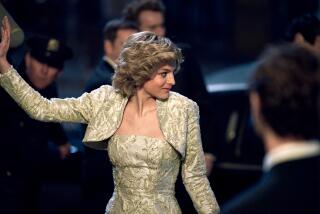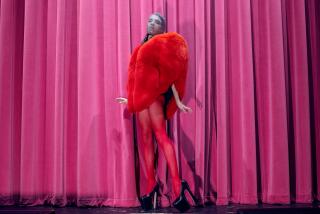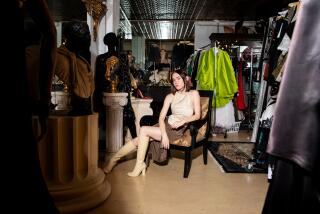DECORATING : Styles Fit for a Queen : Victoriana, Once Thought Ridiculous, Reigns Again in Rugs, Fabrics and Knickknacks of Modern Parlors
She reigned for more than 60 years, filling the thrones of Europe with her heirs, and the parlors and drawing rooms of her time with a grace and style of living that was known as Victorian.
The “Old Queen” created a mood as well as an era. Victorian values were based on the sanctity of home and family, and whether one lived in a simple cottage or a Renaissance Revival mansion, a man’s house was indeed his castle. For generations, American interest in Victoriana has swung in and out of favor. It seems to peak when we are overcome with nostalgia and filled with a longing for things past. Right now, Victoriana is fashionable.
Things that could scarcely be given away a few years ago are being searched for, revived and relished. Junk shops are scavenged and Grandma’s attic is again being explored. Oddities previously dubbed silly, if not downright ridiculous, are sought with unrivaled passion.
Fanciful Victorian fretwork, stained-glass windows and marble mantels are being snatched from the wrecker’s crane and reinstated in country cottages and urban apartments. And for the time being the “Gingerbread” era has been welcomed back.
Huge Queen Anne houses are no longer considered Victorian monstrosities but rather architectural jewels with towers, turrets and gables. Their interiors boast heavy wood paneling, decorative hardware and monumental staircases with newel posts and gracefully turned balusters.
Gothic Revival cottages, complete with Italianate verandas and cupolas, and original Victorian floor plans still exist for those choosing to re-create an authentic Victorian milieu. But the exuberance, warmth and charm of Victorian living can be obtained more easily and less expensively with reproductions of Victorian plaster moldings and ornamentation, a few well-chosen pieces and personal accessories.
A fashionable Victorian drawing room of 1850 would be eclectic in style, furnished with heavily carved, massive chairs, elaborately ornamented inlaid tables, mahogany chests with turned legs, and a bit of Queen Anne; or perhaps a piece or two echoing the English fascination with the French style of Louis XV with its deep narrow moldings.
It would also not be surprising to find a high-backed well-upholstered fringed sofa, a pointed Gothic chair, an upright piano, a black walnut whatnot shelf and, of course, an inlaid tea table perched on a luxurious Oriental carpet. Soft layered draperies would cover the windows and tables; watercolors would grace the walls, and surfaces would be covered with a melange of bibelots, quirky little objects and mementos.
House plants would be tucked into every nook and cranny, from huge palms to Boston ferns.
Though Victorian purists favor authentic furniture, most of us would prefer to create a 19th Century aura without sacrificing modern comforts and conveniences. It is possible, with the wealth of Victorian-style reproductions and authentic pieces available, to achieve the vintage charm of an era when “home was a haven.”
The opulence and luxury of flower-strewn fabrics and new carpets with a time-worn look are available. Bayberry Inc. recently introduced “Melanie,” an exclusive cabbage-rose print based on a 19th-Century French painting, and Karastan is designing Oriental-style carpets that help set a Victorian mood.
Imported from England are original Staffordshire Comforter dogs produced from 1840 to 1900 and based on Queen Victoria’s own spaniel, along with papier-mache tea tables, old needlework, twisted candlesticks, bamboo whatnot stands and a unique collection of desk accessories, picture frames and glass and silver biscuit barrels.
English Spaniels are also being reproduced as bookends and box lids by Fitz & Floyd, which also shows “Blushing Rose,” a collection of bowls, planters, vases, teapots, picture frames and additional accessories of satin-finished bone china with pale pink roses that were inspired by Queen Victoria.
The Victorians were passionate about nature, and in many homes prints of plants in elaborate frames hung from the walls. Easily obtainable, old and new botanical lithographs echo the Victorian revival. Antique pieces in new handmade French mats are available as well as exact reproductions of the Vilmorin garden vegetable series first published in 1885, the popular 35-image Great Flower Prints and the series, “A Dozen Roses,” among the top Victorian-flavor decorating prints available today.
The passion for frills and fancy was carried over to every aspect of Victorian life. Family celebrations took on the aura of coronations, but no occasion was handled with quite the pomp and circumstance of a Victorian wedding.
When Queen Victoria married her beloved Albert, not a detail was overlooked; the wedding cake, it was reported, was as elaborate as the regal bride and her surroundings. The sweet summit of the royal nuptials weighed 300 pounds and was decorated with roses and cupids, topped by an ice sculpture of Britannia.
But it was their fourth daughter, Princess Louise, whose wedding confection literally took the cake. This three-tier extravaganza was festooned with roses, shamrocks, thistles, cornucopias, baskets of fruits and flowers and monogrammed shields. It was crowned with a vase of flowers and silk banners edged in silver. Each tier of the cake was bordered with trellis work and studded with pearls.
Victoriana was opulence, but it was also fun. It was the era of Punch and Judy and Lewis Carroll, amusing trifles, children’s toys, gentility and an appreciation of the past. It was a life filled with pretty things: vases of flowers, bits of lace and the philosophy that for every space there is an object.
The ambience can be captured in a contemporary setting by reinterpreting the ornamentation, the innovation and the colorful sense of Victorian design.
Listen carefully--amid the cozy splendor, you can almost hear the taffeta rustle.
(c) copyright 1994, Roberta Graff. Distributed by the Los Angeles Times Syndicate.


